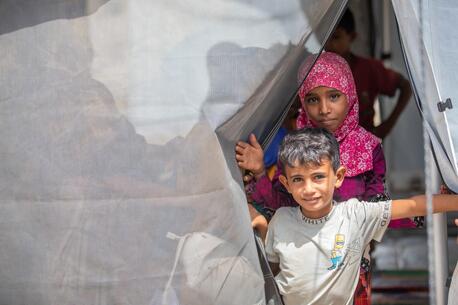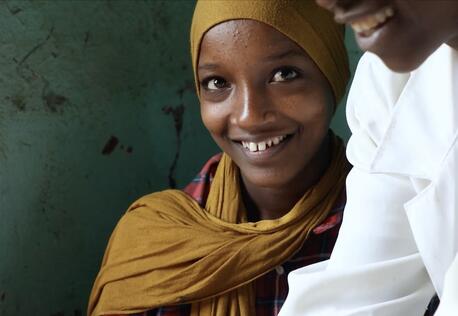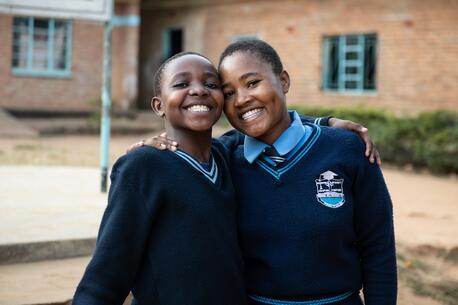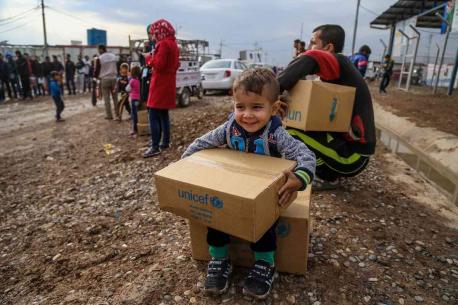
How UNICEF Gets Vital Supplies to Where They're Needed Most
When disaster strikes, UNICEF's supply operation springs into action to get medicine, sanitation kits and other emergency items to children and families in need within 72 hours. A look at the impact of UNICEF's supply operation in 2018.
Whenever a storm or other extreme weather event — like Hurricane Dorian — threatens to devastate an area of the world where children and families are particularly vulnerable, the UNICEF supply operation gets ready. Emergency supplies are pre-positioned for delivery once needs are assessed, in coordination with local authorities.
And UNICEF is able to get vital supplies to their destination in as quickly as 48 to 72 hours, thanks to an increasingly sophisticated supply and logistics operation headquartered at the UNICEF supply warehouse in Copenhagen, the largest facility of its kind in the world.
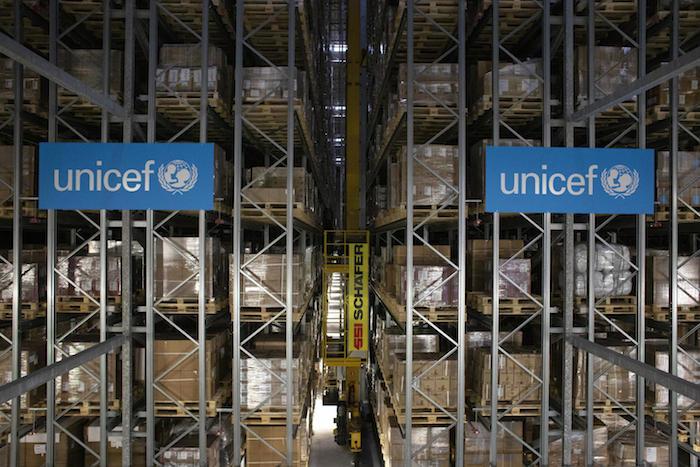
High-bay warehouse at the UNICEF’s Supply Division in Copenhagen, the world's largest humanitarian warehouse. With support from additional warehouses in Dubai and Panama, when an emergency hits, UNICEF can get lifesaving supplies and technical specialists from the Copenhagen center on the ground responding to the needs of children and families within 72 hours. © UNICEF/UN0297760/Nabrdalik VII
The main types of supplies that UNICEF procures are vaccines, medicines and health supplies; water and sanitation items; Ready-to-Use Therapeutic Food (RUTF) and other nutritional supplements; and classroom learning materials. In 2018 alone, UNICEF mobilized $412.6 million in emergency supplies to support humanitarian relief efforts in Nigeria, South Sudan, Venezuela and over 50 other countries and areas.
Another $3 billion worth of goods and services were procured in 2018 to support ongoing interventions for vulnerable children in health, education and other key areas in 150 countries, including:
- 2.36 billion doses of vaccines to protect against measles, diphtheria, tetanus, HPV and other vaccine-preventable diseases, reaching nearly half the world’s children under age 5
- 1.26 billion water purification tablets and sachets of disinfectant to provide kids and families with safe water
- nearly 48,000 tons of RUTF to treat severely malnourished children
- 13.3 million bednets to protect against malaria and other mosquito-borne illnesses
- 4.5 million schoolbags and 84,000 education kits to help out-of-school kids get back to learning
With over 1,000 staff members around the world, UNICEF's Supply Division works year after year to increase efficiencies and otherwise improve results for children.
The job "is not as simple as buying products off the shelf," says Copenhagen-based Director of UNICEF Supply Division Etleva Kadilli. "It requires close collaboration with diverse partners to ensure children in different countries and areas get what they need to live, improve their lives and be safe and healthy.”
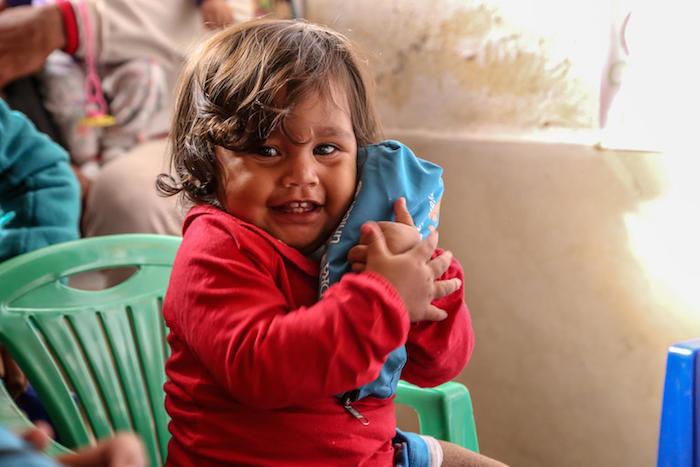
One-year-old Aranza from Cojedes, Venezuela, was one of thousands of recipients of sanitation kits distributed by UNICEF as part of the emergency response to the country's ongoing economic and social crisis. In 2018, UNICEF procured close to $3.5 billion worth of goods and services for children in 150 countries and areas. © UNICEF/UN0326766/Moreno Gonzalez
To fulfill that mission, UNICEF works with governments, businesses and other partners around the world, supporting the development of innovative products and approaches to better meet the needs of the hardest-to-reach. As situations in countries become more complex — especially during emergencies — the ability to adapt, and to do things differently, is critical in order to maximize impact for children and their families.
In 2018, UNICEF convened 11 separate industry consultations to discuss ways to improve delivery of essential goods and services to those who need them most. One of these landmark events — held in Abuja, Nigeria, with representatives from more than 30 sanitation manufacturers from Cote d’Ivoire, Ghana and Nigeria — has since spawned a new initiative to make household toilets and sanitation services more accessible and more affordable to children and families in West Africa.
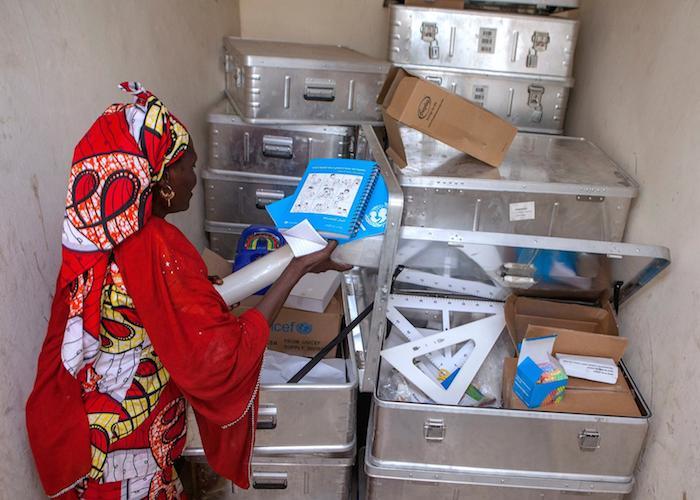
Teacher Yafati Sanda looks over a supply of School-in-a-Box kits provided by UNICEF to support children living at the Dalori camp for displaced people in Maiduguri, Borno State, Nigeria. The kits, which contain enough supplies and materials to support one teacher and up to 40 students, are designed to help kids whose lives have been disrupted by conflict and other emergencies to continue their education in an informal, safe space. Ms. Sanda, who manages the camp's learning center, was the principal at the Government Secondary School in Bama until the town was attacked by Boko Haram insurgents. © UNICEF/UNI193697/Esiebo
UNICEF Supply has also worked to increase the proportion of goods it procures from local businesses, which shortens lead times, lowers shipping costs and reduces UNICEF's overall carbon footprint — while also spurring much-needed economic growth in those local markets.
Over half of the goods that UNICEF procures for children in Syria, for example — water, sanitation and hygiene kits; health and education supplies — come from local sources. In 2018, winter clothes procured from five local suppliers in Syria reached over half a million children affected by the ongoing conflict there.
And after years of working with partners to reshape the market for RUTF in 2018, a record 65 percent of the global supply of the peanut paste packets was procured from manufacturers in countries where UNICEF has nutrition programs. (In 2006, only 6 percent of RUTF was procured locally.)
UNICEF's relationships with multinational businesses are also important. When a measles outbreak sickened more than 2,200 men, women and children in Georgia, UNICEF's relationship with a major measles vaccine manufacturer was instrumental in securing access to 100,000 doses of the measles vaccine to contain the outbreak.
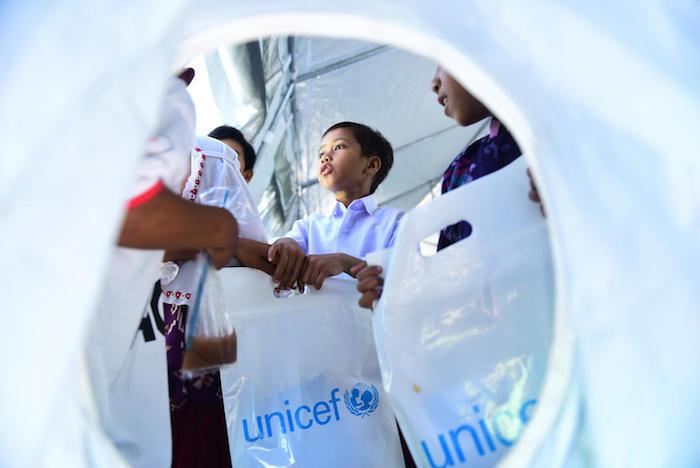
Elementary school students in Talise Village, Palu, Indonesia, receive school supplies from UNICEF to help them get back to learning shortly after their village was destroyed by an earthquake and tsunami. © UNICEF/UN0326758
“The support of governments, businesses, donors and our partners on the ground has been invaluable in allowing us to reach millions of children as quickly as possible — yet the needs remain immense,” Kadilli says. “Sustainable, long-term funding must continue to be a priority for us to meet the needs of children in increasingly complex situations.”
For more information about UNICEF's supply operations and results for 2018, download the annual report.
Top photo: A young Syrian refugee staying in a camp in East Lebanon receives a box of warm winter clothing provided by UNICEF as part of its annual distribution to vulnerable children and families in the region. Items that UNICEF procured from five local suppliers reached over half a million children affected by the ongoing conflict. © UNICEF/UN0326770
HOW TO HELP
There are many ways to make a difference
War, famine, poverty, natural disasters — threats to the world's children keep coming. But UNICEF won't stop working to keep children healthy and safe.
UNICEF works in over 190 countries and territories — more places than any other children's organization. UNICEF has the world's largest humanitarian warehouse and, when disaster strikes, can get supplies almost anywhere within 72 hours. Constantly innovating, always advocating for a better world for children, UNICEF works to ensure that every child can grow up healthy, educated, protected and respected.
Would you like to help give all children the opportunity to reach their full potential? There are many ways to get involved.



